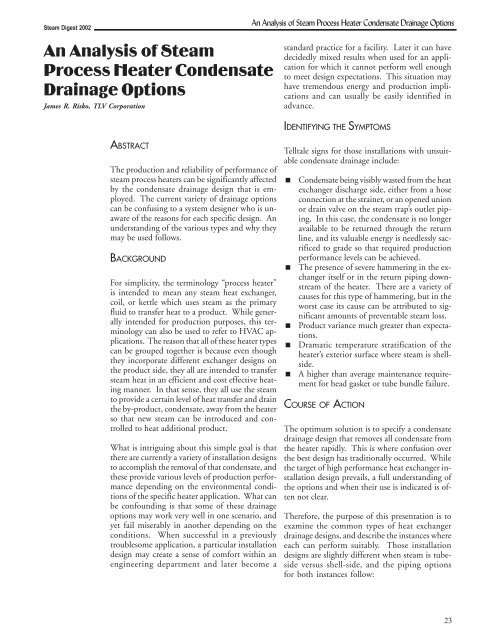Steam Digest 2002 - CiteSeerX
Steam Digest 2002 - CiteSeerX
Steam Digest 2002 - CiteSeerX
You also want an ePaper? Increase the reach of your titles
YUMPU automatically turns print PDFs into web optimized ePapers that Google loves.
<strong>Steam</strong> <strong>Digest</strong> <strong>2002</strong><br />
An Analysis of <strong>Steam</strong><br />
Process Heater Condensate<br />
Drainage Options<br />
James R. Risko, TLV Corporation<br />
ABSTRACT<br />
The production and reliability of performance of<br />
steam process heaters can be significantly affected<br />
by the condensate drainage design that is employed.<br />
The current variety of drainage options<br />
can be confusing to a system designer who is unaware<br />
of the reasons for each specific design. An<br />
understanding of the various types and why they<br />
may be used follows.<br />
BACKGROUND<br />
For simplicity, the terminology “process heater”<br />
is intended to mean any steam heat exchanger,<br />
coil, or kettle which uses steam as the primary<br />
fluid to transfer heat to a product. While generally<br />
intended for production purposes, this terminology<br />
can also be used to refer to HVAC applications.<br />
The reason that all of these heater types<br />
can be grouped together is because even though<br />
they incorporate different exchanger designs on<br />
the product side, they all are intended to transfer<br />
steam heat in an efficient and cost effective heating<br />
manner. In that sense, they all use the steam<br />
to provide a certain level of heat transfer and drain<br />
the by-product, condensate, away from the heater<br />
so that new steam can be introduced and controlled<br />
to heat additional product.<br />
What is intriguing about this simple goal is that<br />
there are currently a variety of installation designs<br />
to accomplish the removal of that condensate, and<br />
these provide various levels of production performance<br />
depending on the environmental conditions<br />
of the specific heater application. What can<br />
be confounding is that some of these drainage<br />
options may work very well in one scenario, and<br />
yet fail miserably in another depending on the<br />
conditions. When successful in a previously<br />
troublesome application, a particular installation<br />
design may create a sense of comfort within an<br />
engineering department and later become a<br />
An Analysis of <strong>Steam</strong> Process Heater Condensate Drainage Options<br />
standard practice for a facility. Later it can have<br />
decidedly mixed results when used for an application<br />
for which it cannot perform well enough<br />
to meet design expectations. This situation may<br />
have tremendous energy and production implications<br />
and can usually be easily identified in<br />
advance.<br />
IDENTIFYING THE SYMPTOMS<br />
Telltale signs for those installations with unsuitable<br />
condensate drainage include:<br />
Condensate being visibly wasted from the heat<br />
exchanger discharge side, either from a hose<br />
connection at the strainer, or an opened union<br />
or drain valve on the steam trap’s outlet piping.<br />
In this case, the condensate is no longer<br />
available to be returned through the return<br />
line, and its valuable energy is needlessly sacrificed<br />
to grade so that required production<br />
performance levels can be achieved.<br />
The presence of severe hammering in the exchanger<br />
itself or in the return piping downstream<br />
of the heater. There are a variety of<br />
causes for this type of hammering, but in the<br />
worst case its cause can be attributed to significant<br />
amounts of preventable steam loss.<br />
Product variance much greater than expectations.<br />
Dramatic temperature stratification of the<br />
heater’s exterior surface where steam is shellside.<br />
A higher than average maintenance requirement<br />
for head gasket or tube bundle failure.<br />
COURSE OF ACTION<br />
The optimum solution is to specify a condensate<br />
drainage design that removes all condensate from<br />
the heater rapidly. This is where confusion over<br />
the best design has traditionally occurred. While<br />
the target of high performance heat exchanger installation<br />
design prevails, a full understanding of<br />
the options and when their use is indicated is often<br />
not clear.<br />
Therefore, the purpose of this presentation is to<br />
examine the common types of heat exchanger<br />
drainage designs, and describe the instances where<br />
each can perform suitably. Those installation<br />
designs are slightly different when steam is tubeside<br />
versus shell-side, and the piping options<br />
for both instances follow:<br />
23
















